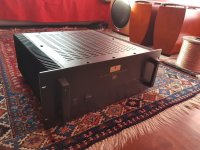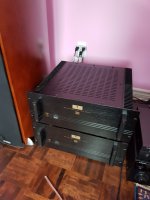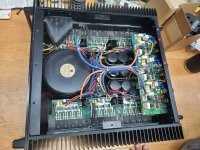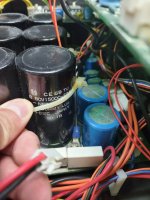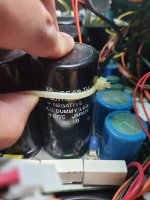Greetings,
New member, first post and just found out about this lovely community with tons of knowledge.
Long story short, 5 years ago I bought 2x Parasound HCA 2003 and used them for a short period of time until they went back to storage.
Fast forward to today, I will be finishing my Home Theater setup in my basement and will bring back my Parasound from storage.
I always wanted to service them, replace the caps and whatever needs to be done to give them another 20 years of life.
I see that there is an mod upgrade for the HCA 3500 being shared by bigskyaudio which by the way I was always wanted to send my units to them for servicing and always told my self that will do that eventually. I should have done that sooner since Big Sky retired and closed the shop 🙁
My question is:
Any help would be appreciated.
Regards
Manyakus
New member, first post and just found out about this lovely community with tons of knowledge.
Long story short, 5 years ago I bought 2x Parasound HCA 2003 and used them for a short period of time until they went back to storage.
Fast forward to today, I will be finishing my Home Theater setup in my basement and will bring back my Parasound from storage.
I always wanted to service them, replace the caps and whatever needs to be done to give them another 20 years of life.
I see that there is an mod upgrade for the HCA 3500 being shared by bigskyaudio which by the way I was always wanted to send my units to them for servicing and always told my self that will do that eventually. I should have done that sooner since Big Sky retired and closed the shop 🙁
My question is:
- Is there an upgrade mod available for the HCA 2003?
- Any recommendation on what to do with them? what to change, remove, replace? I will be sending them to a technician in this coming fall.
- Is the upgrade done on the HCA 3500 similar to HCA 2003?
Any help would be appreciated.
Regards
Manyakus
Attachments
After contacting Parasound USA and Canada, the main person who had all the knowledge for these legacy product has long gone retired.
I contacted several Hi Fi technician repair shop and none of them knows of any upgrade/mods for these Parasound.
They all said they only change the cap and make sure the bias setting is good.
That being said, since I know how to solder, I opened up the amp and looked at the capacitor.
It seems to me they were made by Panasonic but I am not sure.
Which brand would recommend for a 80V 15,000µF?
At that stage, since I am not paying someone to do the job, I will put the money on the Cap, so whatever they cost is not an issue as long they are same or better than OEM.
Give me your recommendation.
Cheers!
I contacted several Hi Fi technician repair shop and none of them knows of any upgrade/mods for these Parasound.
They all said they only change the cap and make sure the bias setting is good.
That being said, since I know how to solder, I opened up the amp and looked at the capacitor.
It seems to me they were made by Panasonic but I am not sure.
Which brand would recommend for a 80V 15,000µF?
At that stage, since I am not paying someone to do the job, I will put the money on the Cap, so whatever they cost is not an issue as long they are same or better than OEM.
Give me your recommendation.
Cheers!
Attachments
Amps deteriorate both because of years on the shelf, and hours service life. Since these have been in storage, the best caps for these may be the caps already installed. Parasound was not a cost cutter brand. I would buy some 8 ohm resistors exceeding the wattage rating per channel of the amp. Hook them up on the speaker terminals with 16 ga wire or thicker. DON"T CAUSE A SHORT ON SPEAKER, THIS DAMAGES THE AMP. Then I would crank up the volume on a typical radio signal in, compressed pop/rock stations tend to run at maximum value all the time. Read the voltage out on the resistors with an Analog AC voltmeter, if you want true numbers. DVM not costing >$150 with an "RMS" rating up tend to lie about voltage on music frequencies. RMS DVmeters typically won't see signals above 7000 hz and thus are useless for detecting ultrasonic oscillation, so I never bought one.
P=(V^2)/Z where P is rated per channel power and Z is speaker impedance (or resistor in this case). I've found $25-30 analog VOM to be adequate for this test. You can check dc volts calibration with a zener diode purchased from a major parts house.
If amp performs to the specification, I would leave it alone. If caps are dried up, the amp tends to sound polite, with no peaks as are common in romantic era classical music. Pop/rock, you can't tell till the amp goes silent.
I rebuild geriatric amps & electric organs. I use Panasonic, rubicon, nichicon, vishay, or kemet brand caps. All these brands make a 500 hour or 1000 hour service life cap for those that wish to repair a unit as cheaply as possible. These are widely stocked and come up on the selector table first since they are cheapest. An amp can accrue 1000 hours in less than a year. Yes, lower temperatures will extend the actual life versus the rating, but I start out with the cap with the longest service life I can buy in a package that will fit in the space available. I had to re-e-cap one amp 4 times in 50 years when the only caps I could buy were the ones in the bins out front of the local TV parts store. Now that pro warehouses will sell to individuals with a debit card and no stupid questions, I typically buy 3000 hours up caps, although I have installed some 12000 hour caps. Extended temperature rating multiplies the quoted number by some unknown value. Don't expect a pro warehouse to answer a lot of newby questions on the phone. Look up your parts on-line.
Beware the selector function on hours service life, some software count a 300 hour cap as longer life than a 1000 hour cap. I inspect the life category individually. Size dimensions & rated voltage & value, the tables get those right.
If I couldn't get the big 5 cap brands, I have used CDE & united Chemicon. These brands typically come from a country known for lying on QA paperwork, and if you look at the datasheet, their numbers tend to have a higher ripple value at end of life than the reliable 5. None of the caps I've bought from them has caused problems. But my 14 hour a day amp (FM radio) has caps from the big 5.
P=(V^2)/Z where P is rated per channel power and Z is speaker impedance (or resistor in this case). I've found $25-30 analog VOM to be adequate for this test. You can check dc volts calibration with a zener diode purchased from a major parts house.
If amp performs to the specification, I would leave it alone. If caps are dried up, the amp tends to sound polite, with no peaks as are common in romantic era classical music. Pop/rock, you can't tell till the amp goes silent.
I rebuild geriatric amps & electric organs. I use Panasonic, rubicon, nichicon, vishay, or kemet brand caps. All these brands make a 500 hour or 1000 hour service life cap for those that wish to repair a unit as cheaply as possible. These are widely stocked and come up on the selector table first since they are cheapest. An amp can accrue 1000 hours in less than a year. Yes, lower temperatures will extend the actual life versus the rating, but I start out with the cap with the longest service life I can buy in a package that will fit in the space available. I had to re-e-cap one amp 4 times in 50 years when the only caps I could buy were the ones in the bins out front of the local TV parts store. Now that pro warehouses will sell to individuals with a debit card and no stupid questions, I typically buy 3000 hours up caps, although I have installed some 12000 hour caps. Extended temperature rating multiplies the quoted number by some unknown value. Don't expect a pro warehouse to answer a lot of newby questions on the phone. Look up your parts on-line.
Beware the selector function on hours service life, some software count a 300 hour cap as longer life than a 1000 hour cap. I inspect the life category individually. Size dimensions & rated voltage & value, the tables get those right.
If I couldn't get the big 5 cap brands, I have used CDE & united Chemicon. These brands typically come from a country known for lying on QA paperwork, and if you look at the datasheet, their numbers tend to have a higher ripple value at end of life than the reliable 5. None of the caps I've bought from them has caused problems. But my 14 hour a day amp (FM radio) has caps from the big 5.
Last edited:
This is a good read. Without testing and just replacing parts just because someone else said to is a waste of time. Parasound used great components, and I would think that if you want to tweak or freshen up the amplifier the first investment should be some good test instruments. DMM, oscilloscope. Good luck with your project. I always liked the Parasound HCA series.
Bring each amp up to nominal AC line voltage very slowly with a fused Variac, over 20 minutes or so.
Then burn it in for an hour or two. If all looks good, power down, disconnect the Variac, and finish testing.
Don't fix what's not broken.
Then burn it in for an hour or two. If all looks good, power down, disconnect the Variac, and finish testing.
Don't fix what's not broken.
Just having a look at your pics, concur, they didn't cheap out. Replacing the large filter caps, unsure that would be worth it, and almost everything else are film caps which look great and don't deteriorate. Tweak, that's another subject; I see a few electrolytics I might swap out if I had to satisify an urge to do something, may add a marginal improvement overall but not night and day. I'm a big wire guy, one of the things I'd look for is replacing internal wiring with silver - but at that point you're in the tweak end of the spectrum, not maintenance. Repair shops most likely don't tweak anything and probably charge you way too much to replace the few electrolytics you have - there is a case to be made to just leave it..
Thank you all for your comments.
Let me see how I can do the tests mention above.
Out of curiosity, how many life hours do generally these cap have? Are we talking 1000, 3000, 5000, 10000 hours?
These amps are at least 25 years old.
If they are still good today, wouldnt they go bad soon (in a couple of years)?
Let me see how I can do the tests mention above.
Out of curiosity, how many life hours do generally these cap have? Are we talking 1000, 3000, 5000, 10000 hours?
These amps are at least 25 years old.
If they are still good today, wouldnt they go bad soon (in a couple of years)?
Depends on how they were designed, used and stored. They could be perfectly fine after a short burn-in.
My used daily family stereo amp is from the 70s, all stock, and sounds great.
Don't be worried about problems that don't exist.
My used daily family stereo amp is from the 70s, all stock, and sounds great.
Don't be worried about problems that don't exist.
Problems which don't exist, yes, and what is it worth to you? They might be out of spec a bit, replacing them might give you a small improvement in overall punch, but at $40+/can and you have 12 to do + the handful of elecs in the signal areas (which are arguably more important) that's $500 in caps + service if you pay someone - for (IMO) a minimal to null benefit in overall sound - dunno.
If the amps were mine and wanted a project, I'd leave the large filter cans alone, replace all of the other electrolytic. There are others far more technical than I, but the loss of spec is not as linear as that - it's age, temp, especially temp, hours - sure, but a few variables go into ESR.
If the amps were mine and wanted a project, I'd leave the large filter cans alone, replace all of the other electrolytic. There are others far more technical than I, but the loss of spec is not as linear as that - it's age, temp, especially temp, hours - sure, but a few variables go into ESR.
Yes, if the itch is insurmountable, just replace the lowest voltage electrolytics
(often 6.3V to 16V parts are used in certain locations).
They degrade over time due to the low DC voltage across them.
With a quality electrolytic capacitor and properly chosen specs, rated capacitor lifetime can be increased by a large factor.
Ten times longer lifetime is easy, and even 100 times is possible. The factory spec lifetime is worst case.
(often 6.3V to 16V parts are used in certain locations).
They degrade over time due to the low DC voltage across them.
With a quality electrolytic capacitor and properly chosen specs, rated capacitor lifetime can be increased by a large factor.
Ten times longer lifetime is easy, and even 100 times is possible. The factory spec lifetime is worst case.
Would unsoldering one cap and measuring its capacitance be a good way to know once for all if they are still within spec?
BTW, these amp haven't been powered since a solid 4-5 years. Don't know if this is a good or bad thing for a capacitor life.
BTW, these amp haven't been powered since a solid 4-5 years. Don't know if this is a good or bad thing for a capacitor life.
Dried up caps tend to read high on the capacitance range. They do read high ESR, which value changes depending on the size & voltage of the cap. If you really want to test them, an Atlas Peak ESR meter is about $120. The table for the typical ESR values is in the brochure shipped with it.
Cheap caps like in a Apex or Acme DTV converter can deteriorate in a year on the shelf. Parasound was a company aiming at a higher point of the market than ***-mart that sold me the DTV converter with the diagonal lines in the picture the day I bought it.
True, the smaller caps fail before the big ones typically. Lower ratio of water to seal area. Signs of this are not enough highs or lows depending on the cap being bypass or pass location. Full power wattage can be low because input or coupler caps are high ESR value, not just the mains caps. If you don't want to do super time consuming power versus frequency test, listen to some full range tracks on this amp versus some other newer amp. I find piano (all octaves), bass octave organ, bass drum and tinkly cymbals & bells to be difficult sound to reproduce properly.
I find a scope unnecessary for doing most amp repair. Used scopes are chock full of electrolytic caps that fail before the ones in an amp will. Plus if you step on a probe, is is a $50 mistake, not $10 like meter probes.
DC scale of DVM is useful for repairing a blown up amp, but most the cheap ones lie on music on the AC scale. They are designed to be accurate at 50-60 hz the power line frequencies. Meters with a pointer get this more accurately on 20 vac or 50 VAC scale and are surprisingly cheap at the hardware store or ebay. Beware the Klein meter at HD or other home stores. The probes are so shielded that you can't put an alligator clip on them. Plus if you buy replacement probes with banana plugs, they pop out of the hole of the Klein meter.
Signal generator (sine wave generator) can be used for a full power test, but a cheap FM radio with an earphone jack provides a better one time test. If no classical station is available for full frequency test, a CD or MP3 player will work. Use earphone port at only 1/3 volume, they typically will put out 7 vac on a 10000 ohm input, and amps usually will distort (clip) with signals greater than 2 vac or even 1.2 vac in some cases. Clipping sounds like a siren. Of course a stereo 1/8" phone plug to dual RCA plug converter cable is necessary. Which you buy at the same time as the 8 ohm (or 4 ohm if that is your amp rating) high wattage resistors. I use Ohmmite or dale log resistors, 225 or 250 w covers most home amps. An array of cheaper 10w or 20 w wirewound resistors can be more inexpensive if assembled, but requires a board to mount them on and some hours work. I do have my logs on a metal stand so they don't burn the carpet or worktable.
Cheap caps like in a Apex or Acme DTV converter can deteriorate in a year on the shelf. Parasound was a company aiming at a higher point of the market than ***-mart that sold me the DTV converter with the diagonal lines in the picture the day I bought it.
True, the smaller caps fail before the big ones typically. Lower ratio of water to seal area. Signs of this are not enough highs or lows depending on the cap being bypass or pass location. Full power wattage can be low because input or coupler caps are high ESR value, not just the mains caps. If you don't want to do super time consuming power versus frequency test, listen to some full range tracks on this amp versus some other newer amp. I find piano (all octaves), bass octave organ, bass drum and tinkly cymbals & bells to be difficult sound to reproduce properly.
I find a scope unnecessary for doing most amp repair. Used scopes are chock full of electrolytic caps that fail before the ones in an amp will. Plus if you step on a probe, is is a $50 mistake, not $10 like meter probes.
DC scale of DVM is useful for repairing a blown up amp, but most the cheap ones lie on music on the AC scale. They are designed to be accurate at 50-60 hz the power line frequencies. Meters with a pointer get this more accurately on 20 vac or 50 VAC scale and are surprisingly cheap at the hardware store or ebay. Beware the Klein meter at HD or other home stores. The probes are so shielded that you can't put an alligator clip on them. Plus if you buy replacement probes with banana plugs, they pop out of the hole of the Klein meter.
Signal generator (sine wave generator) can be used for a full power test, but a cheap FM radio with an earphone jack provides a better one time test. If no classical station is available for full frequency test, a CD or MP3 player will work. Use earphone port at only 1/3 volume, they typically will put out 7 vac on a 10000 ohm input, and amps usually will distort (clip) with signals greater than 2 vac or even 1.2 vac in some cases. Clipping sounds like a siren. Of course a stereo 1/8" phone plug to dual RCA plug converter cable is necessary. Which you buy at the same time as the 8 ohm (or 4 ohm if that is your amp rating) high wattage resistors. I use Ohmmite or dale log resistors, 225 or 250 w covers most home amps. An array of cheaper 10w or 20 w wirewound resistors can be more inexpensive if assembled, but requires a board to mount them on and some hours work. I do have my logs on a metal stand so they don't burn the carpet or worktable.
Last edited:
Parasound got back to me saying they have the caps in stock.
I don't know what age they have, guessing any cap have shelf life, but I guess I want to try them out on one Amplifier and compare the sound with the other identical Amplifier that I own too.
One will have refreshed OEM cap and the other amp will still have the original cap.
I know I will get replies that it is useless, wasting money, etc..
But I can't help it, I want to do the test 🙂
I don't know what age they have, guessing any cap have shelf life, but I guess I want to try them out on one Amplifier and compare the sound with the other identical Amplifier that I own too.
One will have refreshed OEM cap and the other amp will still have the original cap.
I know I will get replies that it is useless, wasting money, etc..
But I can't help it, I want to do the test 🙂
Unless the source track has a wide dynamic range, and you listen at a level high enough to exceed the amount of voltage swing the rail caps can support, you won't hear a difference. The cheapest test to detect dried up rail caps is listed in post #3. ~$25 for an analog Voltmeter, ~$50 for two 8 ohm 225 W resistors, $8 for a 1/8" stereo phone plug to dual RCA plug adapter cable, $7 for a FM radio with earphone jack. Alternatively the Peak Atlas ESR meter is $120 to test the caps individually. If you do the voltage out test on a load, you don't have to take the cover off the amp and unsolder the rail caps. Screw terminal caps could be unscrewed, but replacements screw terminal caps cost 2-5 times as much as snap-in types.Parasound got back to me saying they have the caps in stock.
I don't know what age they have, guessing any cap have shelf life, but I guess I want to try them out on one Amplifier and compare the sound with the other identical Amplifier that I own too.
Remember small caps often dry up before big ones. The Allen S-100 amp I worked on, changing rail caps only got it from 2 watts to 25 watts. It took a hard to find 75 uf 50 v bipolar cap as coupler to drive the wattage up to 100. The small caps mostly have to be unsoldered to test ESR.
Last edited:
Ok correct me if I am wrong:
The test in post #3 is to replace the speaker with a 8 ohm resistor having at least 220W rating since my Parasound can deliver that.
Then crank up the sound, which in my case the resistor will heat up.
Measure the voltage on the output and plug V in that formula, where Z is the measured ohm of the resistor.
P=(V^2)/Z
If P is lower than 220W (rating of my amp) then I have a bad capacitor.
Correct?
The test in post #3 is to replace the speaker with a 8 ohm resistor having at least 220W rating since my Parasound can deliver that.
Then crank up the sound, which in my case the resistor will heat up.
Measure the voltage on the output and plug V in that formula, where Z is the measured ohm of the resistor.
P=(V^2)/Z
If P is lower than 220W (rating of my amp) then I have a bad capacitor.
Correct?
Yes. If the amp has one pair of rail caps for each channel, then you can test the channels individually. If the amp has one rail cap pair for both channels, you need two 8 ohm resistors to test both channels at once. I have my resistor logs mounted on a metal plate with ears to hold the resistors up to keep them from burning the carpet or coffee table.
If the amp rating is at 4 ohms instead of 8, that is what you need for resistors.
Z of a speaker is usually 4/3 of the measured resistance. Due to the inductance of the drivers. Z of a wirewound resistor is approximately equal to the resistance. Notice measuring 8 or 4 ohms usually requires a fresh battery for a DVM.
You may have more than dried up rail caps. Coupler and first stage filter caps can be dried up too. I find in 30 year old Peavey products the 2.2 uf input caps are usually a problem.
I found 5 ohm 225 watt Dale logs for $5 each at a surplus house, but that may have been a one time bargain. Apexelectronic is out of the resistor business. Surplussales.com & electronicsurplus.com usually charge 80% of new price for high wattage resistors.
If the amp rating is at 4 ohms instead of 8, that is what you need for resistors.
Z of a speaker is usually 4/3 of the measured resistance. Due to the inductance of the drivers. Z of a wirewound resistor is approximately equal to the resistance. Notice measuring 8 or 4 ohms usually requires a fresh battery for a DVM.
You may have more than dried up rail caps. Coupler and first stage filter caps can be dried up too. I find in 30 year old Peavey products the 2.2 uf input caps are usually a problem.
I found 5 ohm 225 watt Dale logs for $5 each at a surplus house, but that may have been a one time bargain. Apexelectronic is out of the resistor business. Surplussales.com & electronicsurplus.com usually charge 80% of new price for high wattage resistors.
Last edited:
If you're set on doing this, you'll probably hear a difference - 10-15% change is my guess - but what electrolytics are you talking about, the main filter caps? Not sure that will bring much to you. It's better you focus on all of the ones in the signal path / amp boards IMO. But in order to do your test, you really need to cook in the new capacitors probably for a minimum of 3-4 days with the unit constantly on, to get a real feel for what changed. If you change out capacitors, plug it in and compare differences, it's just won't be accurate that way. Lastly, I'd suggest now that you've sold yourself on this idea, to look into better caps - what does Parasound have to send? would it be worthwhile to buy your own premium capacitors? ..I would..Parasound got back to me saying they have the caps in stock.
I don't know what age they have, guessing any cap have shelf life, but I guess I want to try them out on one Amplifier and compare the sound with the other identical Amplifier that I own too.
One will have refreshed OEM cap and the other amp will still have the original cap.
I know I will get replies that it is useless, wasting money, etc..
But I can't help it, I want to do the test 🙂
In 2018 when I changed the main caps on a 1980 Allen S-100 amp the wattage went immediately from 2 to 25. That's a 12,500% change. Pretty audible even in my music room. When I changed all the other little caps wattage went from 25 to 100. Immediately. 400% change. Less audible but was detectable at full volume in a 200 seat auditorium.But in order to do your test, you really need to cook in the new capacitors probably for a minimum of 3-4 days with the unit constantly on, to get a real feel for what changed.
When I changed 77 caps 2 at a time in a 1968 H182 Hammond organ, I tried the sound after every 2. Most of them made the sound better: immediately. Some made functions work, like the envelope functions, attack & string bass.
I used long service life (>3000 hours) Panasonic, nichicon, rubicon, United Chemicon or Multicomp (newark house brand) caps. Except some twist-in lug aluminum can caps were from FE. No problems. No "audio grade" adjectives to run the price up 300%. About 50% more expensive than 500 or 1000 hour industrial caps.
oh, no question there will be an immediate change, the sound will just likely evolve over that time, so for purposes of an AB test, it likely won't be accurate right out of the gate - at least based on many experiences I've had.
I'll second this. Very good advice. Parasound used very good components and its unlikely they need to be replaced.Bring each amp up to nominal AC line voltage very slowly with a fused Variac, over 20 minutes or so.
Then burn it in for an hour or two. If all looks good, power down, disconnect the Variac, and finish testing.
Don't fix what's not broken.
- Home
- Amplifiers
- Solid State
- Parasound HCA 2003 - Rebuild/Upgrade
